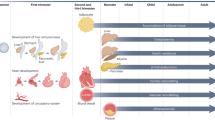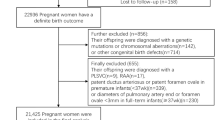Abstract
Background
Although childhood cardiovascular risk can contribute to adult cardiovascular disease, and fertility and adult cardiovascular health are linked, the association between early-life cardiovascular risk and female infertility has not been studied.
Methods
A total of 1799 women participated in the Babies substudy of the Bogalusa Heart Study. Systolic blood pressure (SBP), diastolic blood pressure (DBP), low-density lipoprotein (LDL), high-density lipoprotein (HDL), triglycerides, glucose, and insulin were age-standardized and examined as predictors of self-reported fertility difficulties using multivariable logistic regression with adjustment for confounders. Polycystic ovarian syndrome (PCOS) was assessed via a report of diagnosis and symptoms, using a validated questionnaire.
Results
Women with a history of PCOS were more likely to report fertility difficulties. Childhood and adolescent cardiovascular risk factors were generally not associated with fertility indicators, although childhood LDL (aOR 1.38 per one-SD increase, 0.97–1.96) and total cholesterol (aOR 1.49, 1.06–2.11) were raised in those who never became pregnant. Pre-pregnancy risk SBP (overall fertility, aOR 1.49, 1.00–2.23) and glucose levels (ever tried but unable, aOR 2.65, 1.39–5.06) were associated with an increased risk of some infertility indicators. These results were largely unaffected by exclusion of women with PCOS.
Conclusion
Some childhood and pre-pregnancy cardiovascular risk factors are associated with adult subfertility.
Similar content being viewed by others
Log in or create a free account to read this content
Gain free access to this article, as well as selected content from this journal and more on nature.com
or
References
Chandra, A., Copen, C. E., & Stephen, E. H. Infertility and impaired fecundity in the United States, 1982-2010: data from the National Survey of Family Growth. Natl Health Stat. Report 1–18 (1 p following 19) (2013).
Homan, G. F., Davies, M. & Norman, R. The impact of lifestyle factors on reproductive performance in the general population and those undergoing infertility treatment: a review. Hum. Reprod. Update 13, 209–223 (2007).
Ray, A., Shah, A., Gudi, A. & Homburg, R. Unexplained infertility: an update and review of practice. Reprod. Biomed. Online 24, 591–602 (2012).
Quaas, A. & Dokras, A. Diagnosis and treatment of unexplained infertility. Rev. Obstet. Gynecol. 1, 69–76 (2008).
Lane, M., Zander-Fox, D. L., Robker, R. L. & McPherson, N. O. Peri-conception parental obesity, reproductive health, and transgenerational impacts. Trends Endocrinol. Metab. 26, 84–90 (2015).
Jacobs, M. B., Bazzano, L. A., Pridjian, G., & Harville, E. W. Childhood adiposity and fertility difficulties: the Bogalusa Heart Study. Pediatr. Obes. 12, 477–484 (2017).
Wise, L. A., Palmer, J. R. & Rosenberg, L. Body size and time-to-pregnancy in black women. Hum. Reprod. 28, 2856–2864 (2013).
Sundaram, R., Mumford, S. L. & Buck Louis, G. M. Couples’ body composition and time-to-pregnancy. Hum. Reprod. 32, 662–668 (2017).
Pugh, S. J. et al. Preconception maternal lipoprotein levels in relation to fecundability. Hum. Reprod. 32, 1055–1063 (2017).
Schisterman, E. F. et al. Lipid concentrations and couple fecundity: the LIFE study. J. Clin. Endocrinol. Metab. 99, 2786–2794 (2014).
Verit, F. F., Yildiz Zeyrek, F., Zebitay, A. G. & Akyol, H. Cardiovascular risk may be increased in women with unexplained infertility. Clin. Exp. Reprod. Med. 44, 28–32 (2017).
Parikh, N. I., Cnattingius, S., Mittleman, M. A., Ludvigsson, J. F. & Ingelsson, E. Subfertility and risk of later life maternal cardiovascular disease. Hum. Reprod. 27, 568–575 (2012).
Westerlund, E. et al. Incidence of hypertension, stroke, coronary heart disease, and diabetes in women who have delivered after in vitro fertilization: a population-based cohort study from Sweden. Fertil. Steril. 102, 1096–1102 (2014).
Berenson, G. S., Srinivasan, S. R. & Bao, W. Precursors of cardiovascular risk in young adults from a biracial (black-white) population: the Bogalusa Heart Study. Ann. N. Y. Acad. Sci. 817, 189–198 (1997).
McGill, H. C. Jr, McMahan, C. A., Malcom, G. T., Oalmann, M. C. & Strong, J. P. Effects of serum lipoproteins and smoking on atherosclerosis in young men and women. The PDAY Research Group. Pathobiological Determinants of Atherosclerosis in Youth. Arterioscler. Thromb. Vasc. Biol. 17, 95–106 (1997).
El Hayek, S., Bitar, L., Hamdar, L. H., Mirza, F. G. & Daoud, G. Polycystic ovarian syndrome: an updated overview. Front. Physiol. 7, 124 (2016).
March, W. A. et al. The prevalence of polycystic ovary syndrome in a community sample assessed under contrasting diagnostic criteria. Hum. Reprod. 25, 544–551 (2010).
Joham, A. E., Boyle, J. A., Zoungas, S. & Teede, H. J. Hypertension in reproductive-aged women with polycystic ovary syndrome and association with obesity. Am. J. Hypertens. 28, 847–851 (2015).
Diamanti-Kandarakis, E., Spritzer, P. M., Sir-Petermann, T. & Motta, A. B. Insulin resistance and polycystic ovary syndrome through life. Curr. Pharm. Des. 18, 5569–5576 (2012).
Orio, F., Palomba, S., & Colao, A. Cardiovascular risk in women with polycystic ovary syndrome. Fertil. Steril. 86, S20–S21 (2006).
Birdsall, M. A., Farquhar, C. M. & White, H. D. Association between polycystic ovaries and extent of coronary artery disease in women having cardiac catheterization. Ann. Intern. Med. 126, 32–35 (1997).
Berenson, G. S. et al. Association between multiple cardiovascular risk factors and atherosclerosis in children and young adults. The Bogalusa Heart Study. N. Engl. J. Med. 338, 1650–1656 (1998).
Dick, M. L. et al. Self-reported difficulty in conceiving as a measure of infertility. Hum. Reprod. 18, 2711–2717 (2003).
Herbert, D., Lucke, J. & Dobson, A. Agreement between self-reported use of in vitro fertilization or ovulation induction, and medical insurance claims in Australian women aged 28-36 years. Hum. Reprod. 27, 2823–2828 (2012).
Joffe, M. Methods for obtaining valid data on time to pregnancy among men and women. Scand. J. Work. Environ. Health 25, 8–9 (1999).
Zielhuis, G. A., Hulscher, M. E. & Florack, E. I. Validity and reliability of a questionnaire on fecundability. Int. J. Epidemiol. 21, 1151–1156 (1992).
Cooney, M. A., Buck Louis, G. M., Sundaram, R., McGuiness, B. M. & Lynch, C. D. Validity of self-reported time to pregnancy. Epidemiology 20, 56–59 (2009).
Berkey, C. S. et al. Longitudinal height velocity standards for U.S. adolescents. Stat. Med. 12, 403–414 (1993).
Paley, J. et al. The multiplier method for prediction of adult height. J. Pediatr. Orthop. 24, 732–737 (2004).
Pedersen, S. D., Brar, S., Faris, P. & Corenblum, B. Polycystic ovary syndrome: validated questionnaire for use in diagnosis. Can. Fam. Physician 53, 1042–1047 (2007). 1041.
Davies, M. J. Evidence for effects of weight on reproduction in women. Reprod. Biomed. Online 12, 552–561 (2006).
Frisch, R. E. Body fat, menarche, fitness and fertility. Hum. Reprod. 2, 521–533 (1987).
Verit, F. F., Keskin, S., Omer, B., Yalcinkaya, S. & Sakar, N. Is there any relationship between cardiovascular risk markers and young women with diminished ovarian reserve? Gynecol. Endocrinol. 30, 697–700 (2014).
Talbott, E. et al. Coronary heart disease risk factors in women with polycystic ovary syndrome. Arterioscler. Thromb. Vasc. Biol. 15, 821–826 (1995).
Ghaffarzad, A., Amani, R., Mehrzad Sadaghiani, M., Darabi, M. & Cheraghian, B. Correlation of serum lipoprotein ratios with insulin resistance in infertile women with polycystic ovarian syndrome: a case control study. Int. J. Fertil. Steril. 10, 29–35 (2016).
Wellons, M. Cardiovascular disease and primary ovarian insufficiency. Semin. Reprod. Med. 29, 328–341 (2011).
Wise, J. Women with endometriosis show higher risk for heart disease. BMJ 353, i1851 (2016).
Vannuccini, S. et al. Infertility and reproductive disorders: impact of hormonal and inflammatory mechanisms on pregnancy outcome. Hum. Reprod. Update 22, 104–115 (2016).
Sotiriadis, A., Makrigiannakis, A., Stefos, T., Paraskevaidis, E. & Kalantaridou, S. N. Fibrinolytic defects and recurrent miscarriage: a systematic review and meta-analysis. Obstet. Gynecol. 109, 1146–1155 (2007).
Chan, M. Y., Andreotti, F. & Becker, R. C. Hypercoagulable states in cardiovascular disease. Circulation 118, 2286–2297 (2008).
Guzick, D. S. et al. Infertility evaluation in fertile women: a model for assessing the efficacy of infertility testing. Hum. Reprod. 9, 2306–2310 (1994).
Acknowledgements
The Bogalusa Heart Study is supported by National Institutes of Health grants R01HD069587, AG16592, HL121230, HD032194, and P50HL015103.
Author information
Authors and Affiliations
Corresponding author
Ethics declarations
Competing interests
The authors declare no competing interests.
Additional information
Publisher's note: Springer Nature remains neutral with regard to jurisdictional claims in published maps and institutional affiliations.
Electronic supplementary material
Rights and permissions
About this article
Cite this article
Wang, Y., Xiong, X., Bazzano, L. et al. Childhood cardiovascular health and subfertility: the Bogalusa Heart Study. Pediatr Res 84, 625–631 (2018). https://doi.org/10.1038/s41390-018-0032-x
Received:
Revised:
Accepted:
Published:
Issue date:
DOI: https://doi.org/10.1038/s41390-018-0032-x
This article is cited by
-
Commentary on “Childhood cardiovascular health and subfertility: The Bogalusa Heart Study”
Pediatric Research (2018)



